While near-infrared (NIR) light therapy offers natural pain relief benefits, you'll need to watch for six key risks. Without proper eye protection, you could experience retinal damage. You might notice temporary skin redness, irritation, or increased sensitivity in treated areas. Some medications can interact dangerously with NIR therapy, especially photosensitizing drugs. Certain medical conditions like cancer and lupus require extra caution. Dehydration can reduce the treatment's effectiveness and increase discomfort. If you exceed recommended treatment times, you risk overexposure and tissue damage. Understanding these risks and proper safety protocols will help guarantee your NIR therapy journey stays both effective and safe.
Understanding Near-Infrared Light Basics

Near-infrared light penetrates beneath the surface of what we can see with our naked eyes, operating in a spectrum just beyond visible light at wavelengths between 700nm and 1,100nm. While you can't see or feel NIR light directly, it's actively working at a cellular level, distinct from far-infrared light which produces noticeable heat sensations. Operating at higher temperatures around 1200°F, NIR delivers immediate and intense therapeutic effects.
When NIR light enters your body's tissues, it triggers a chain of beneficial reactions. It stimulates your cells through photoacceptor molecules, particularly cytochrome c oxidase, which enhances your body's ATP production – the energy currency of your cells. This process supports natural healing and pain relief without invasive procedures.
You'll find NIR light therapy most effective when combined with red and yellow light treatments. This combination approach amplifies the therapeutic benefits, including reduced inflammation, accelerated wound healing, and improved tissue repair.
NIR's ability to penetrate deep into your tissues makes it particularly valuable for treating musculoskeletal injuries and chronic pain conditions. Unlike many conventional pain treatments, NIR therapy offers a safe, non-invasive option with no known side effects when properly administered.
Common Side Effects
When you receive NIR treatment, you'll typically notice temporary redness and a warm sensation in the treated area, which usually subsides within a few hours.
Your eyes might experience strain or discomfort if you don't use proper protective eyewear during the treatment sessions. Some individuals experience frequent headaches or migraines from the bright light exposure.
You may also develop mild skin irritation, including slight itching or sensitivity, though these reactions are generally short-lived and resolve on their own.
Temporary Redness and Warmth
A mild flush of redness and warmth commonly occurs during and after NIR therapy sessions. These effects typically result from increased blood flow and cellular energy production in treated areas. While they're usually harmless and temporary, lasting only a few hours post-treatment, you'll want to monitor your skin's response carefully. The therapy works by stimulating ATP production to enhance healing and cellular repair.
| Normal Reactions | Warning Signs |
|---|---|
| Mild warmth | Intense burning |
| Light redness | Severe redness |
| Slight tingling | Blistering |
| Temporary flush | Persistent pain |
| Brief sensitivity | Lasting discomfort |
You'll need to take proper precautions to minimize these side effects. Always use protective goggles to shield your eyes, and follow the manufacturer's guidelines for treatment duration and distance. If you have sensitive skin or are taking medications that increase photosensitivity, you should consult your healthcare provider before starting treatment.
Unlike UV tanning or long-term pain medication use, NIR therapy's side effects are generally mild and localized. However, if you experience any severe reactions or persistent discomfort, discontinue use immediately and seek medical attention. Staying hydrated during treatment can help optimize results and potentially reduce these temporary effects.
Eye Strain Symptoms
Beyond skin reactions, eye strain ranks among the most reported side effects of NIR therapy, particularly when proper eye protection isn't used. During treatment, you'll need to pay attention to any vision-related discomfort, as prolonged exposure to NIR light can cause several uncomfortable symptoms.
Poor lighting and screen glare can significantly increase symptoms. You might experience tired, sore, or itchy eyes during or after your sessions, especially if you're looking directly at or too close to the NIR device. Watch for signs like blurred or double vision, which can indicate that your eyes are struggling to maintain proper focus.
Some users report headaches or neck pain, often resulting from poor positioning during treatment sessions.
If you notice your eyes becoming unusually dry or watery, or you're having trouble concentrating during treatment, these are clear indicators of eye strain.
To protect yourself, always wear appropriate protective eyewear during NIR sessions, and follow the 20-20-20 rule if you're using a full-body device. Take regular breaks, maintain proper distance from the NIR source, and safeguard that you're in a well-lit room to minimize strain.
If symptoms persist, consult your healthcare provider about adjusting your treatment protocol.
Mild Skin Irritation
During NIR therapy sessions, mild skin irritation commonly occurs as your body's natural response to the treatment. This irritation typically manifests as temporary redness, minor itching, or a slight feeling of tightness in the treated areas. You might experience sensations similar to a mild sunburn, though without the UV damage associated with sun exposure. Most people feel a gentle warming sensation during treatment.
Your skin's reaction stems from increased cellular activity and tissue repair processes triggered by the NIR treatment. If you have pre-existing skin conditions, you may be more susceptible to irritation.
While these symptoms usually resolve on their own, you'll need to take precautions to prevent complications.
To minimize skin irritation, you should apply high SPF sunscreen and avoid direct sunlight for several weeks after treatment. It's essential to work with a qualified professional and follow all treatment guidelines carefully.
You'll also want to discuss any skin conditions you have before starting therapy. While at-home NIR devices are available, they're generally less effective than professional equipment and may carry additional risks if misused.
Remember that the long-term effects of NIR treatment aren't fully understood yet, making proper medical supervision essential.
Skin Damage Warning Signs

When using NIR treatment, recognizing early signs of skin damage can prevent serious complications. You'll need to watch for blistering, redness, rashes, or unusual skin reactions during and after treatment sessions. If you experience any of these symptoms, stop treatment immediately and seek medical attention.
You shouldn't exceed recommended treatment times of 10-20 minutes per session, as prolonged exposure can damage your skin. Even with home devices, which are typically less powerful than professional equipment, improper use can lead to burns and blisters. Following the manufacturer's instructions is essential for your safety. Creating a treatment schedule of sessions one to three times per week can help you maintain consistency while avoiding overexposure.
If you're pregnant, have cancer, skin conditions, or photosensitivity, you must consult your doctor before starting NIR therapy. Some medications can increase your skin's sensitivity to treatment, making you more susceptible to damage. You'll also need medical clearance if you have a history of skin cancer or eye disease.
After treatment, monitor your skin closely and keep it hydrated. Track your progress and any reactions you experience. Regular check-ups with your healthcare provider will help verify you're using NIR therapy safely and effectively.
Protecting Your Eyes
Your eyes need specialized protective eyewear during NIR treatments to prevent potential retinal damage and adverse effects.
When using NIR devices, you'll want to maintain a safe distance of at least 6 inches from your eyes and never stare directly at the light source. Extended viewing exceeds safety exposure limits and could lead to permanent eye damage.
You should also limit your eye-area treatment sessions according to manufacturer guidelines, which typically range from 3-5 minutes per session, and watch for any signs of discomfort or afterimages.
Proper Eyewear Selection Essential
Selecting appropriate eye protection consistently ranks as the most critical safety measure for NIR therapy users. You'll need specialized eyewear that blocks specific wavelengths between 600-900nm and 700-1400nm, as regular sunglasses won't provide adequate protection against NIR exposure.
When choosing protective eyewear, look for products with high OD ratings (OD 4+ or 5+) that meet ANSI Z87.1 and CE EN166 safety standards. You can choose between IR3 or IR5 attenuation levels, offering 80% to 95% reduction in light intensity.
The best options are made from polycarbonate materials and offer extensive protection against near infrared, blue light, and UV radiation.
Don't compromise on comfort – select lightweight, non-bulky designs that you'll actually wear consistently during treatments.
Maintain Safe Light Distance
Proper distance management stands out as another essential factor in protecting your eyes during NIR therapy sessions. You'll need to maintain specific distances based on your treatment type to safeguard both safety and effectiveness.
For facial treatments, especially around the eyes, keep a minimum distance of 60 centimeters to prevent potential damage to sensitive eye tissues.
When using NIR therapy, follow these critical distance guidelines:
- Stay 15-30 centimeters away for general skin treatments, which provides the best penetration while minimizing risks of overexposure.
- Position yourself at least 40 centimeters from the device for deep tissue and joint treatments to safeguard proper infrared penetration without discomfort.
- Keep a 60-centimeter distance during facial treatments, particularly when targeting areas near your eyes, even if you're wearing protective eyewear.
If you're using different devices or targeting various body areas, you'll need to adjust these distances accordingly. Don't forget that treatment duration also impacts the ideal positioning – longer sessions may require greater distances.
If you experience any discomfort or unusual sensations, immediately increase your distance from the light source and consult your healthcare provider.
Timing Your Eye Treatments
Treatment timing protocol for eye-related NIR therapy requires careful attention to protect your vision and maximize benefits. Before starting any eye treatments, you'll need to consult an eye care professional for a proper diagnosis, as self-diagnosis can lead to serious complications and vision loss. This step isn't optional – it's essential for determining if NIR therapy is appropriate for your specific condition.
When you're ready to begin treatments, keep your sessions properly timed and structured. You'll need to protect your eyes during each session, either by keeping them closed or using appropriate protective eyewear.
If you're using a device specifically designed for the eye area, follow the manufacturer's recommended treatment duration precisely. These specialized devices typically emit lower-intensity light and include built-in safety features.
Don't delay seeking professional care while attempting self-treatment, as many vision-threatening conditions progress without early symptoms. This is especially important if you're in a high-risk group, such as individuals with diabetes or those of African, Asian, or Caribbean descent.
Regular eye exams should continue throughout your NIR treatment journey to monitor your eye health and adjust protocols as needed.
Drug Interaction Dangers

With multiple medications in your system, drug interactions pose serious risks that can't be ignored. When you're considering NIR treatment while taking medications, you'll need to be especially cautious about potential drug interactions that could affect your safety and treatment outcomes.
Drug-drug interactions become more complex when you're taking multiple medications, and the risks increase substantially with each additional drug in your system.
You should be particularly watchful for these critical interaction risks:
- If you're taking opioids or other CNS depressants, you'll face increased dangers of respiratory depression and sedation, which could become life-threatening when combined with other treatments.
- Serotonergic medications can interact with various drugs to cause serotonin syndrome, a potentially dangerous condition that requires immediate medical attention.
- Certain medications, especially ritonavir and nirmatrelvir, can markedly affect how your body processes other drugs, leading to unexpected side effects or reduced treatment effectiveness.
Always inform your healthcare provider about every medication you're taking, including over-the-counter drugs and supplements. They'll need to carefully evaluate potential interactions before starting any new treatment, including NIR therapy.
Don't hesitate to consult your pharmacist, who can help identify potential drug interaction risks.
Sensitive Skin Considerations
People with sensitive skin need to approach NIR treatment with extra caution and care. If you have fair or sensitive skin, you're more susceptible to NIR penetration, which can cause increased irritation, redness, and potential blistering if not managed properly.
Your skin's protective mechanisms, including water and hemoglobin absorption, may not be enough to prevent discomfort during treatment.
To protect your sensitive skin, you'll need to follow specific safety protocols. Always wear proper eye protection and maintain a consistent distance from the light source.
Start with shorter sessions and gradually increase duration as your skin adapts. If you experience any irritation, reduce your session length or frequency immediately.
Adding a cooling element can help manage surface temperature and prevent thermal effects.
Don't skip post-treatment care – use moisturizers to soothe your skin after sessions. If you have any pre-existing skin conditions or are taking medications, consult your healthcare provider before starting NIR therapy.
Monitor your skin's response closely and document any adverse effects. If you notice persistent redness, itching, or blistering, seek professional medical evaluation before continuing treatment.
Heart Health Precautions
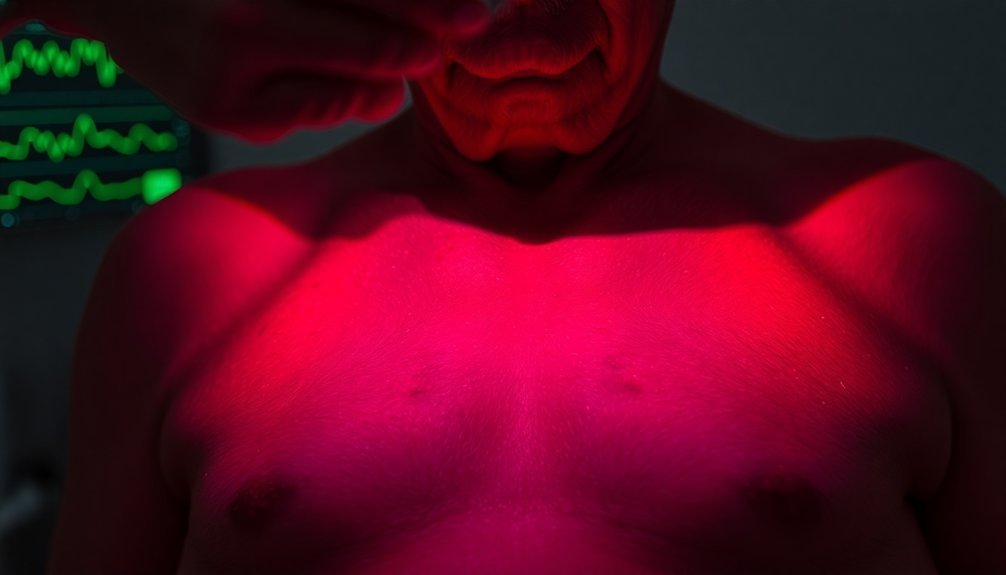
Safety concerns surrounding NIR therapy require special attention when it comes to heart health. While photobiomodulation therapy shows promise for cardiovascular benefits in experimental studies, you'll need to take into account several precautions, especially if you're taking heart medications or NSAIDs.
The interaction between NIR treatment and cardiovascular medications hasn't been fully studied in humans, making it essential to consult your healthcare provider before starting treatment.
If you're managing heart conditions, keep these key factors in mind:
- NIR therapy's effects on blood pressure and circulation may interact with medications you're taking, particularly if you're using NSAIDs or blood pressure medications.
- The therapy's impact on TGF-β1 levels could affect your cardiovascular system, so monitoring is vital if you have existing heart conditions.
- If you're using nitroglycerin or other heart medications that can cause sexual side effects, discuss potential interactions with NIR therapy with your doctor.
Your heart health routine, including prescribed medications, shouldn't be altered without professional guidance. While PBM shows potential benefits for cardiovascular health, more research is needed to fully understand its effects on human heart conditions and medication interactions.
Safe Treatment Guidelines
Establishing clear treatment guidelines for NIR therapy can substantially reduce your risk of adverse effects. You'll need to start by choosing a high-quality device from a reputable manufacturer and following their specific instructions for use.
Position your device carefully to target the intended treatment area, and stick to recommended sessions of 10-20 minutes.
Don't skip wearing protective eyewear during treatments, as your eyes are particularly vulnerable to NIR light exposure.
If you have sensitive skin, tattoos, or medical implants, consult your healthcare provider before starting treatment. You'll want to maintain at least 6 hours between treatments of the same area to prevent overexposure.
For ideal results, you should establish a consistent treatment schedule, typically involving daily sessions for active concerns. Once you've achieved your desired results, you can shift to maintenance sessions.
Remember to properly maintain your device and monitor your skin's response during treatments. If you experience any unusual reactions beyond mild warming or temporary redness, stop treatment immediately and consult a healthcare professional.
While serious risks are minimal with proper use, incorrect application can lead to burns or blistering.
Medical Conditions To Watch
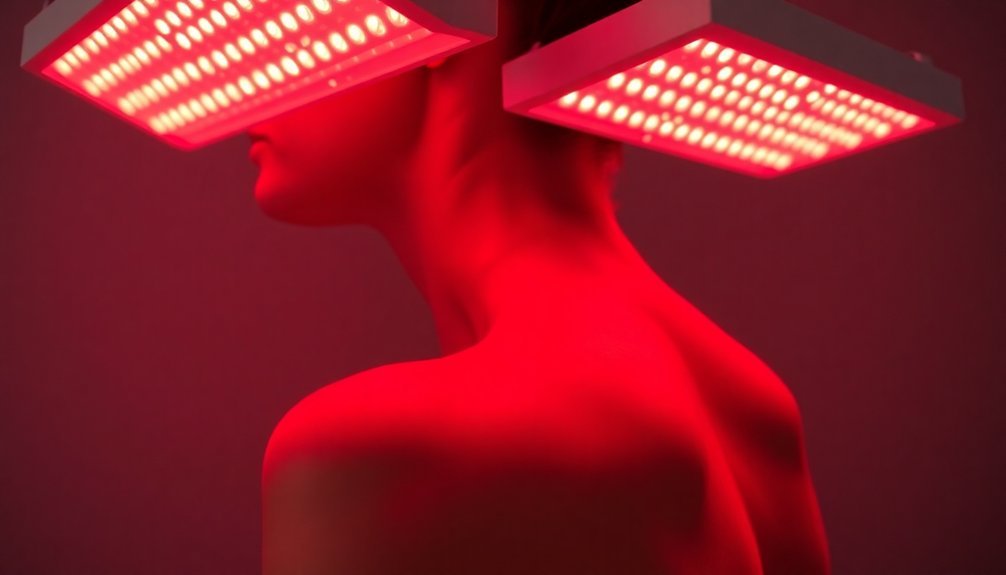
Understanding your medical history is essential before starting NIR therapy, as certain conditions can increase your risk of complications.
If you're dealing with skin conditions like porphyria or lupus, you'll need extra caution since these disorders make your skin more sensitive to light exposure. Similarly, if you've got active cancer or hyperthyroidism, it's vital to avoid NIR therapy until you've consulted with your healthcare provider.
Your medications matter too. Many common prescriptions can make you more sensitive to light treatments:
- Photosensitizing antibiotics and antifungals that increase your skin's reaction to light
- Mood-stabilizing medications like lithium and sleep aids like melatonin that can enhance light sensitivity
- Skin treatments containing tretinoin, which may cause increased redness and irritation when combined with NIR therapy
If you're pregnant, undergoing chemotherapy, or managing systemic conditions like lupus, you'll want to be particularly careful. These situations require special consideration and medical clearance before starting NIR treatment.
Don't forget that certain eye conditions and seizure disorders also warrant extra precautions, and protective eyewear is always necessary during sessions.
Hydration During Treatment
You'll need to drink plenty of water before your NIR therapy sessions to maximize their effectiveness and prevent potential dehydration risks.
It's crucial to track your daily fluid intake, ensuring you consume at least 8-10 glasses of water throughout the day when undergoing NIR treatments.
Your hydration levels directly impact the therapy's benefits, as proper fluid balance supports cellular repair and helps regulate your body temperature during sessions.
Water Before NIR Sessions
Proper hydration before NIR sessions plays an essential role in maximizing treatment effectiveness and minimizing potential risks. When you're well-hydrated, NIR light penetrates deeper into your tissues, enhancing the therapy's ability to provide pain relief and promote healing.
Your body's cells store more energy when properly hydrated, which directly impacts the treatment's success.
Before starting your NIR session, it's imperative to maintain adequate hydration levels to support effective treatment outcomes. You'll want to avoid dehydration, as it can lead to unwanted effects like excessive heating and potential burns during therapy.
Additionally, proper hydration helps facilitate vasodilation, improving blood circulation throughout your treatment area.
- Drink water consistently throughout the day leading up to your session, rather than consuming large amounts right before treatment.
- Monitor your hydration status by checking your urine color – aim for a light, straw-colored appearance.
- Consider combining hydration with other pre-treatment preparations to enhance NIR therapy effectiveness.
If you're not adequately hydrated, you'll risk compromising the pain relief mechanisms associated with NIR therapy and potentially limit the treatment's overall benefits.
Tracking Daily Fluid Intake
While preparing for NIR sessions with adequate hydration is important, maintaining ideal fluid levels during treatment requires careful monitoring. You'll need to track your daily fluid intake to guarantee you're getting enough water to optimize your NIR therapy's effectiveness.
Studies show that proper hydration can enhance the therapy's benefits by up to 30%, primarily by improving your cells' ability to absorb light energy.
To track your hydration effectively, you'll want to monitor both your intake and hydration status. Watch for signs of dehydration like dark urine, dry mouth, or decreased skin elasticity.
You can use apps, water bottles with marked measurements, or simple paper logs to record your daily water consumption. Remember that your specific needs may vary based on factors like activity level, climate, and overall health.
During NIR sessions, your body needs adequate hydration to maintain proper blood flow and support cellular processes. This helps distribute oxygen and nutrients while removing waste products more efficiently.
If you're not properly hydrated, you'll reduce the therapy's effectiveness and potentially limit its pain-relieving benefits by up to 25%.
Professional Guidance Requirements
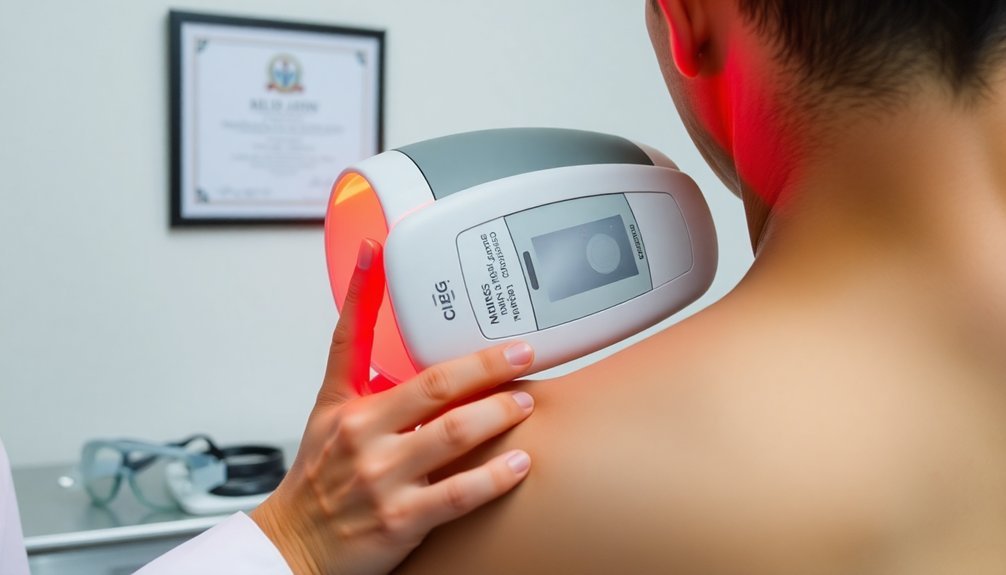
Before starting NIR light therapy, consulting with a qualified healthcare provider is essential for your safety and treatment success. You'll need medical clearance, especially if you've recently undergone surgery, to guarantee proper healing and reduced inflammation.
Your healthcare provider will assess your specific conditions and health status to determine if NIR therapy is appropriate for your needs.
Professional oversight remains vital throughout your treatment journey. Your healthcare provider will customize your treatment plan, monitor for adverse effects, and adjust protocols as needed. They'll also guide you in selecting high-quality devices that have proven clinical effectiveness for your specific condition.
You'll need to maintain regular check-ins with your healthcare provider to guarantee your treatment remains safe and effective.
Your provider will help determine the best frequency and duration of your NIR therapy sessions.
They'll assess your progress and make necessary adjustments to maximize benefits while minimizing risks.
Following your provider's recommendations and treatment protocols is non-negotiable. You must consistently adhere to the prescribed guidelines, including proper device usage and recommended session durations.
If you experience any concerns or side effects, contact your healthcare provider immediately for guidance.
Monitoring Treatment Progress
Working alongside your healthcare provider, you'll need reliable methods to track your NIR therapy's effectiveness. Modern optical spectroscopy devices can measure your blood flow and metabolic signals in real-time, helping you and your doctor monitor how well the treatment is working.
These monitoring devices use multiple wavelengths of light to track various health indicators. They measure the absorption and scattering of lightwaves, allowing your healthcare team to observe changes in blood flow and cellular activity.
The devices can detect the concentration of oxygenated and deoxygenated red blood cells, which serves as a vital indicator of your body's response to treatment.
While some NIR monitoring devices are being developed for home use to enhance convenience, you shouldn't attempt self-monitoring without proper medical supervision. Your healthcare provider needs to interpret the data accurately and adjust your treatment protocol accordingly.
They'll use standardized protocols to guarantee you're receiving the most effective treatment possible. Remember that while these monitoring technologies show promise, many are still in early testing phases, and you'll need professional guidance to guarantee safe and effective treatment outcomes.
Frequently Asked Questions
Can You Use NIR Therapy While Wearing Contact Lenses?
You shouldn't wear regular contact lenses during NIR therapy. It's best to remove them and wear proper protective eyewear instead. If you need NIR therapy, consult your eye doctor for specific safety guidance.
How Long Should You Wait Between NIR Treatments on the Same Area?
You should wait at least 24 hours between NIR treatments on the same area. While you can treat multiple areas in one day, it's best to give each specific spot a full day's rest between sessions.
Does NIR Therapy Interfere With Electronic Medical Devices Like Pacemakers?
NIR therapy generally won't interfere with your pacemaker since it doesn't emit harmful electromagnetic waves. However, you should always consult your healthcare provider first to confirm safety with your specific medical device.
Can NIR Treatment Help With Seasonal Affective Disorder (Sad)?
Yes, you'll find NIR therapy can help with SAD symptoms. Research shows it's effective at improving mood and reducing depression, especially when you use it regularly during darker winter months. It's safe and well-tolerated.
Is It Safe to Use NIR Therapy Immediately After Getting Tattoos?
You shouldn't use NIR therapy immediately after getting a tattoo. Wait at least two weeks for initial healing to complete. The tattoo ink might react negatively to light exposure, and you'll risk infection during healing.
In Summary
You'll need to carefully weigh these NIR treatment risks against potential benefits before starting therapy. Watch for skin reactions, protect your eyes, and stay hydrated throughout sessions. Don't skip consulting your doctor about medication interactions and pre-existing conditions. While NIR therapy offers natural pain relief options, you're responsible for monitoring your progress and stopping treatment if you notice adverse effects.
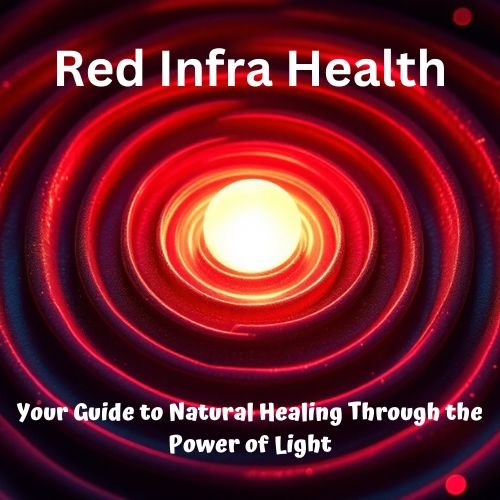
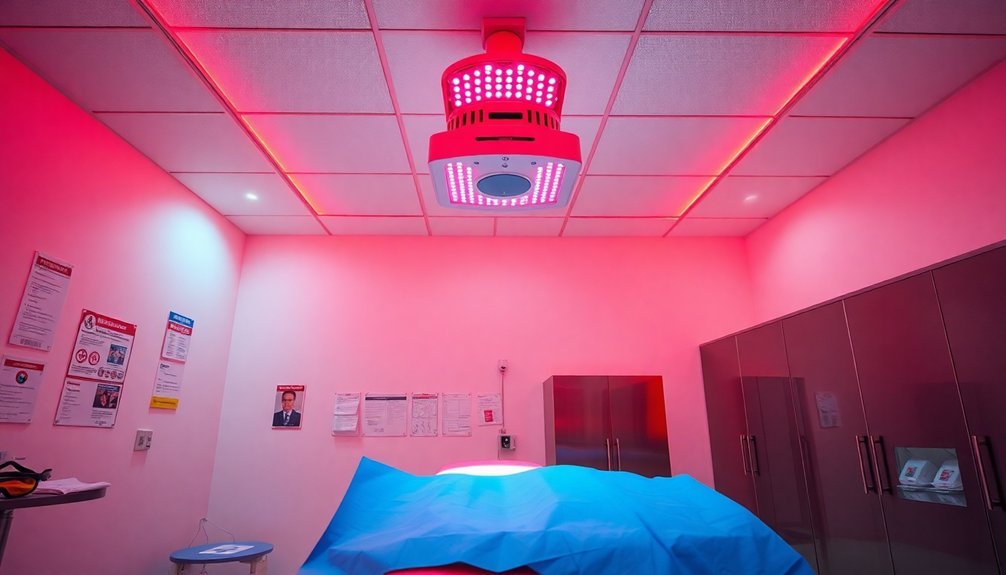

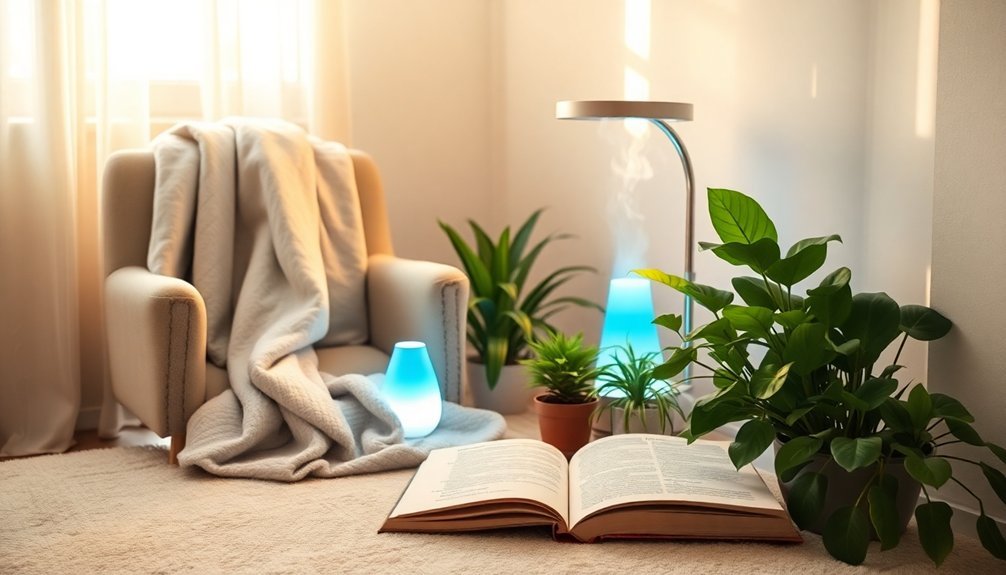

Leave a Reply